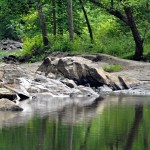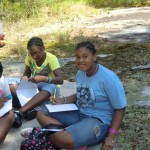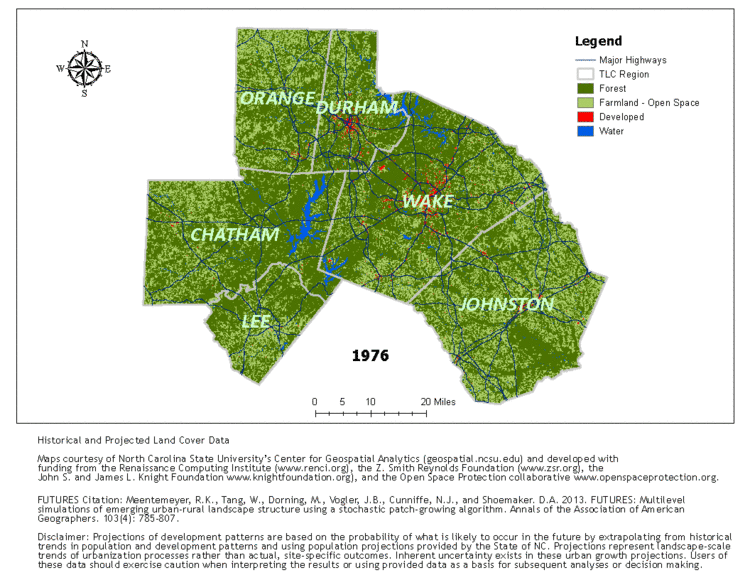Since 1990, the Triangle’s population has more than doubled, from less than 900,000 to somewhere around 1.7 million people, and it is expected to grow another 36% to over 2.3 million people. Certainly, those numbers tell a story, but what do they mean in terms of land use?
This animation vividly shows just how rapidly the Triangle is projected to develop over the next several decades. It was created in Fall 2014 by Charlynne Smith at the Center for Geospatial Analytics at N.C. State University and her graduate-level GIS 590 class. Leslie Sox, a master’s student at NCSU, worked with TLC to produce a growth projection for our six-county region using the FUTURES model originally developed by researchers at UNC Charlotte. The project used historical land cover data and the output from the growth model to show historic and projected growth in the Triangle from 1976 through 2040. The model is based on historical growth patterns, and therefore, does not include major new planned developments, such as Chatham Park.
Current and projected future development of the Triangle make it more important now than ever to strategically invest in land conservation to help maintain a high quality of life for people throughout the region. We know open spaces should be protected, but with limited resources staff time, volunteer energy, and funding—it is necessary to identify and focus on priorities. This is why being strategic is essential to TLC’s land conservation program.
Conservation Initiatives
 TLC has identified specific landscapes in the region as Conservation Initiatives to focus our conservation efforts. These special areas provide the region with important benefits as conserved land, including clean water, natural habitats, local farms and food, and places to connect with nature. Learn more about our targeted conservation initiatives.
TLC has identified specific landscapes in the region as Conservation Initiatives to focus our conservation efforts. These special areas provide the region with important benefits as conserved land, including clean water, natural habitats, local farms and food, and places to connect with nature. Learn more about our targeted conservation initiatives.
Partnerships
 Successful conservation often requires collaboration across organizations and political boundaries. TLC has a long history of partnering with other nonprofits, government agencies, and businesses to conserve wild and working lands in the Triangle, connect people with nature, and more recently, to raise the profile of conservation issues to catalyze community action. Learn more about our partnership projects.
Successful conservation often requires collaboration across organizations and political boundaries. TLC has a long history of partnering with other nonprofits, government agencies, and businesses to conserve wild and working lands in the Triangle, connect people with nature, and more recently, to raise the profile of conservation issues to catalyze community action. Learn more about our partnership projects.
Planning
 TLC actively engages with local, state and federal agencies and other conservation groups in efforts to prioritize landscapes and guide comprehensive conservation strategies. Planning is not glamorous, photogenic, or a lot of fun to talk about, but it is the behind-the-scenes work that makes popular land protection projects happen. Learn more about our planning efforts.
TLC actively engages with local, state and federal agencies and other conservation groups in efforts to prioritize landscapes and guide comprehensive conservation strategies. Planning is not glamorous, photogenic, or a lot of fun to talk about, but it is the behind-the-scenes work that makes popular land protection projects happen. Learn more about our planning efforts.

